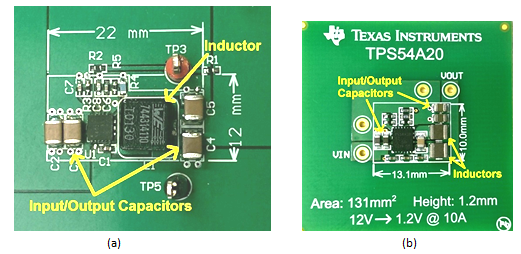SSZTBA1 may 2016 TPS54A20
My wife loves to get flowers. It is amazing how a simple, small gift can bring such a big smile to her face. The flowers brighten up our home and our spirits.
If only reducing voltage regulator size was such a small matter. There often seems to be more components to cram onto a circuit board than space available. More features and functions need to fit in a confined area. Higher levels of integration and Moore’s law have been effective at shrinking some devices but have had little impact on direct current (DC/DC) converter size. Power converters can easily consume 30% to 50% of overall system size. How do you get past this bottleneck?
One obvious answer is to increase operating frequency. Most point-of-load voltage regulators are switching converters using a buck (step-down) topology. Increasing switching frequency reduces the inductance and capacitance required to meet the regulator’s design specifications. Since inductors and capacitors usually take up most of the space in a DC/DC converter, as shown in Figure 1(a), this can be quite effective. But it’s not that simple. So what’s the catch?
 Figure 1 Size Comparison between a
12VIN, 10AOUT Buck Converter Operating at 500kHz (a)
and a Series-capacitor Buck Converter Operating at 2MHz per Phase (b)
Figure 1 Size Comparison between a
12VIN, 10AOUT Buck Converter Operating at 500kHz (a)
and a Series-capacitor Buck Converter Operating at 2MHz per Phase (b)Blindly increasing frequency also increases power loss. Energy is lost every time a switching action occurs. Hence, switching loss scales proportionally with frequency. Conversion efficiency drops and heat dissipation can be a major problem. Frequency is limited to hundreds of kilohertz in most converters today. Those that do operate above 1MHz are typically low voltage (5V and below) and low current (less than 1A).
It’s time to “think outside the buck.” Buck converters have been the workhorse of the industry for decades but have fundamental limitations. We’re excited to introduce a new DC/DC converter topology optimized for high-voltage-conversion-ratio point-of-load applications. The series-capacitor buck converter enables multi-megahertz operation without compromising efficiency. As you can see in Figure 1(b), the reduction in total solution size is quite impressive. For the same input and output conditions as the buck converter in Figure 1(a), the series-capacitor buck converter based on the TPS54A20 is eight times smaller. That’s 1,270 mm3 vs. 157 mm3.
 Figure 2 Height Comparison between a
12VIN, 10AOUT Buck Converter Operating at 500kHz (a)
and a Series-capacitor Buck Converter Operating at 2MHz per Phase (b)
Figure 2 Height Comparison between a
12VIN, 10AOUT Buck Converter Operating at 500kHz (a)
and a Series-capacitor Buck Converter Operating at 2MHz per Phase (b)Voltage regulator size reduction opens the door to new opportunities. Consider the height profiles shown in Figure 2. The conventional buck converter shown in Figure 2(a) is 4.8mm tall. This is well above the height limitation many systems have for their back-side components. The low profile of the series-capacitor buck converter (1.2mm tall) allows you to place the voltage regulator on the back side of your circuit board. This frees up valuable top-side real estate. It was not feasible before to fit an entire 10A converter on the back side – the passive components were too large. With the TPS54A20, now you can.
Additional Resources
- Get more information on the TPS54A20.
- Download the application note “Introduction to the Series Capacitor Buck Converter.”
- Read the white paper “Buck the trend in power conversion with breakthrough topology.”
- Start a design now in WEBENCH® Power Designer.
- Watch a video “How to decrease inductor size in a 10A DC/DC converter design.”
- Download the “Three Different Buck Converter Circuits to Convert 12V to 1.2V at >6A Load Current Reference Design,” which includes a 1.2-V output voltage for double-data-rate (DDR)4 memory applications.
- Learn more about TI’s SWIFT™ portfolio and find technical resources.